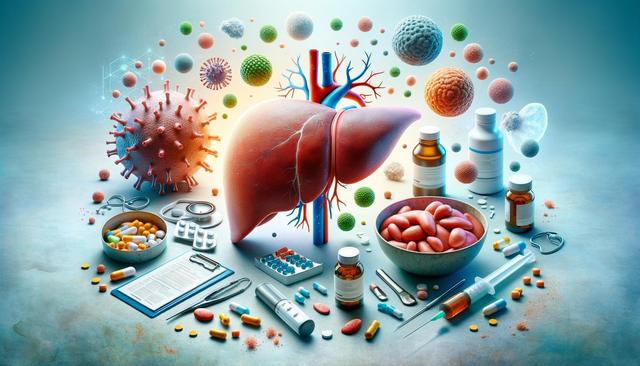
Understanding Liver Cirrhosis: Symptoms, Causes, and Treatment Options
What Is Liver Cirrhosis?
Liver cirrhosis is a chronic condition in which healthy liver tissue is gradually replaced by scar tissue, impairing the liver’s ability to function. This scarring, also known as fibrosis, occurs due to long-term damage from various liver diseases or toxins. Over time, the scar tissue blocks blood flow through the liver and hinders essential processes such as detoxification, nutrient processing, and bile production. The progression of cirrhosis can be slow and silent, especially in its early stages.
Cirrhosis can result from several underlying causes, including:
- Chronic alcohol consumption
- Hepatitis B or C infection
- Non-alcoholic fatty liver disease (NAFLD)
- Autoimmune hepatitis
- Inherited metabolic disorders
Identifying the root cause is essential for effective treatment and to prevent further liver damage. As the disease progresses, symptoms become more apparent and severe, often leading to life-threatening complications.
Recognizing the Symptoms of Cirrhosis
Symptoms of liver cirrhosis can vary depending on the stage of the disease. In the early stages, many people may not experience noticeable symptoms. However, as the liver becomes more damaged, several signs and symptoms tend to appear. Some of the most common symptoms include:
- Fatigue and weakness
- Loss of appetite and weight loss
- Jaundice (yellowing of the skin and eyes)
- Itchy skin
- Swelling in the legs, ankles, or abdomen (ascites)
- Easy bruising and bleeding
- Spider-like blood vessels on the skin
In more advanced cases, individuals may experience confusion, memory problems, and personality changes due to a buildup of toxins in the brain, a condition known as hepatic encephalopathy. If you notice any of these symptoms, it is important to seek medical advice promptly to assess liver function and determine the next steps.
Diagnostic Methods and Monitoring
Diagnosing liver cirrhosis often involves a combination of clinical evaluation, laboratory tests, and imaging studies. Physicians typically begin with a detailed medical history and physical examination to check for signs such as jaundice or fluid retention. Blood tests are used to evaluate liver enzyme levels, clotting ability, and overall liver function.
Imaging techniques such as ultrasound, CT scans, or MRI can help visualize structural changes in the liver and detect complications like tumors or portal hypertension. In some cases, a liver biopsy is performed to confirm the diagnosis and assess the extent of fibrosis. Additionally, non-invasive alternatives like transient elastography (FibroScan) can measure liver stiffness and monitor disease progression over time.
Ongoing monitoring is crucial for individuals with cirrhosis. Regular follow-ups allow healthcare providers to evaluate liver function, manage complications, and adjust treatments as needed. Surveillance for liver cancer is also essential, as people with cirrhosis are at increased risk.
Treatment and Lifestyle Adjustments
While there is no cure for cirrhosis in its advanced stages, treatment aims to slow disease progression, manage symptoms, and prevent complications. Addressing the underlying cause is a critical part of treatment. For example, antiviral medications can help control hepatitis, while abstaining from alcohol is vital for alcohol-related liver disease.
Common treatment strategies include:
- Medications to reduce portal hypertension and manage symptoms
- Diuretics to control fluid buildup
- Endoscopic procedures to treat variceal bleeding
- Vaccinations to prevent infections such as hepatitis A and B
Equally important are lifestyle changes, which may include:
- Eating a balanced, low-sodium diet
- Avoiding alcohol and certain medications
- Engaging in regular physical activity, as tolerated
- Monitoring weight and fluid intake
In some cases, cirrhosis patients may require hospitalization for acute complications, such as infections or gastrointestinal bleeding. As liver function declines, patients may also be evaluated for a liver transplant, which can offer a renewed quality of life when other treatments are no longer effective.
When to Consider a Liver Transplant
A liver transplant is considered when cirrhosis reaches an advanced stage and the liver can no longer perform its vital functions. This procedure involves replacing the damaged liver with a healthy one from a donor. Not everyone with cirrhosis is a candidate for transplantation, and eligibility depends on multiple factors including overall health, the severity of liver dysfunction, and the absence of contraindications like active substance abuse.
The decision to pursue a liver transplant typically follows a thorough evaluation process at a transplant center. Patients are assessed using the Model for End-Stage Liver Disease (MELD) score, which helps prioritize candidates based on the urgency of their condition. While waiting for a suitable donor organ, patients must adhere to strict medical and lifestyle guidelines to remain eligible for the procedure.
After a successful transplant, lifelong medication and follow-up care are necessary to prevent organ rejection and maintain overall health. Although transplantation is a major undertaking, it can significantly improve survival and quality of life for individuals with end-stage cirrhosis.
Conclusion: Taking Proactive Steps Toward Liver Health
Liver cirrhosis is a serious and progressive condition, but early detection and proper management can make a meaningful difference. Understanding the symptoms, causes, and available treatment options empowers individuals to take control of their liver health. Lifestyle modifications, regular check-ups, and adherence to medical advice are essential in slowing disease progression and managing complications.
If you or a loved one are experiencing symptoms of liver dysfunction, consult a healthcare professional for evaluation and guidance. Timely intervention can improve outcomes and, in some cases, open the door to life-saving treatments like liver transplantation. By staying informed and proactive, individuals can better navigate the challenges of cirrhosis and protect their long-term well-being.


